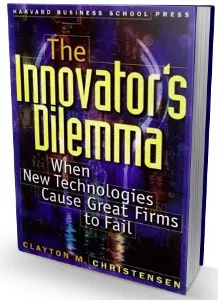If you’ll excuse me for a moment, I want to head off from a display-only topic to talk about a general business issue, that is to say, innovation. In a recent article, one of our analysts queried whether a big company was going to create the ‘next big thing’ in the mobile space. “Almost certainly not,” is my answer. Here’s why.
Really great companies are very good at execution. It’s not enough in business to simply have a good idea; you have to run a good company and work closely with your customers to make sure you’re doing what they want. The better you are at execution and running a responsive business, the closer you are to your customers, and often you are closest to the difficult customers who push you to add features and services and get better.
The reality of truly disruptive technologies is that they often come from directions you don’t see or expect, and your best customers probably won’t use them. PCs are a classic disruptive technology of this type. When they came along, they weren’t particularly useful to the companies that ran mainframe and minicomputers (although PCs could be turned into quite effective terminals for those systems). In fact, they were often a problem to those companies as they allowed individual PC users to do their own thing and bypass the corporate IT department. Over time, they grew and grew in volume. The volume drove reducing cost and that enabled even more volume. With massively increasing volumes, the PC makers – and their supply chain – were able to boost performance and value until they (almost) killed the mainframe business.
In the same way, professional graphics companies (just to get to something more display related!) got driven out by companies that designed game chips. These weren’t as good as the professional systems initially, but the huge volume bought by game players eventually meant that the R&D and other technology went way past that of the companies such as Silicon Graphics and Evans & Sutherland.
In his excellent book, The Innovator’s Dilemma, Clayton Christensen of Harvard set out the logic for why this always happened and why it was (almost) inevitable. His thesis was basically that the better-run the company, and the more successful, the less likely it was to see its competition coming – and even if it did see it, it would have trouble doing anything about it, as giving resources to the disruptive technology would not be supported by customers or internal power structures.
His views changed how a lot of companies tried to develop really innovative technologies. It seemed better, if Christensen was correct, to keep such potentially disruptive outside organisations to allow them to grow and develop and I have certainly believed that at least some part of the activities of huge technology companies such as Intel and Philips have changed how they worked to take the idea into account. Both of those companies invest in outside ventures and start-ups, or spin technologies out from the main company to give them a chance to develop and find their own customer base. Intel has the Intel Capital business which, as well as helping companies that can be helpful to the ecosystem in which Intel competes, can support ideas and ventures that would seem to be potentially the eventual cause of Intel’s demise!
As long ago as 1994, HP was quoted in Fortune magazine as saying “If we don’t eat our own lunch, someone else will”. HP is a classic example of a process-driven, customer responsive organisation that would have trouble doing something that would kill its own businesses. However, the logic of that quote was that what may disrupt you can come from inside. Hmmm… I’m a great admirer of HP, but I find it hard to think of something disruptive it has done since laser printers – and that didn’t, as far as I can see, disrupt a major business (although it probably killed the pen plotters!). Anyway, I’m sure HP’s PR people will be in touch…
Often business books don’t seem to relate to the real world that I see around me, but the The Innovator’s Dilemma did strike a chord and is one of the best business books I’ve read (and I’ve read a lot). If you are in technology marketing, it should be absolutely required reading.
– Bob Raikes

